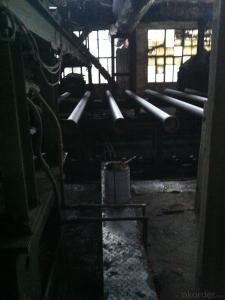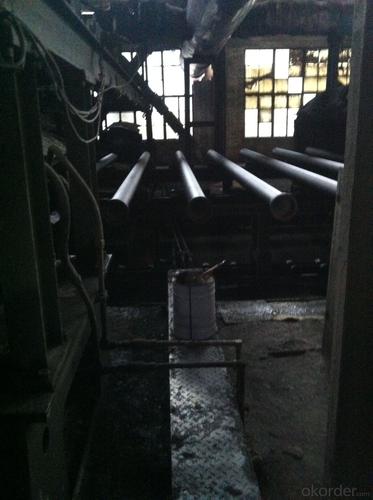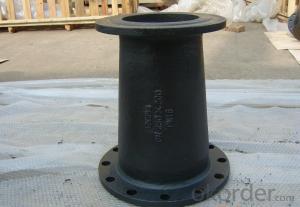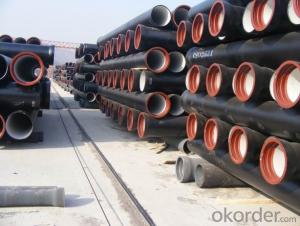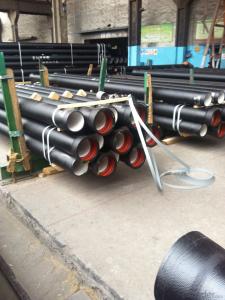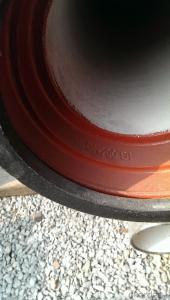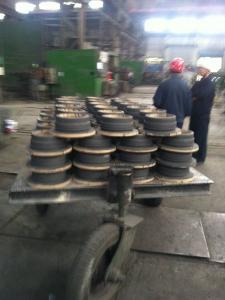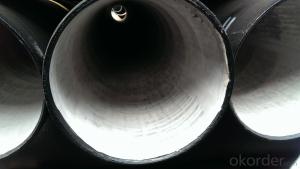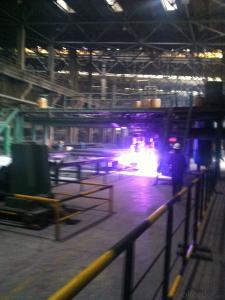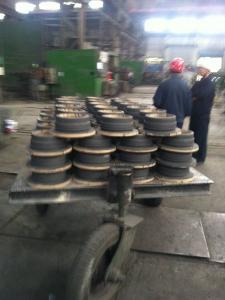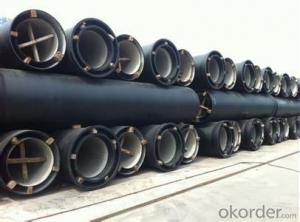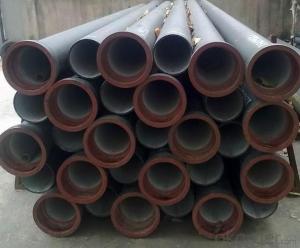DUCTILE IRON PIPES AND PIPE FITTINGS K7 CLASS DN500
- Loading Port:
- Tianjin
- Payment Terms:
- TT OR LC
- Min Order Qty:
- 22 pc
- Supply Capability:
- 3000 pc/month
OKorder Service Pledge
OKorder Financial Service
You Might Also Like
Material : Ductile Cast Iron
Size Range : DN 80mm to DN 2000mm
Unit Effective Length : 6m or 5.7m
Manufacture Standard: ISO 2531:1998/ EN 545:2006/EN 598:2007
Annual capacity : 200,000 tons
Coating Exterior: Zinc 130g/m2 according to ISO 8179-1 and bitumen coating 70 microns.
Cement Interior: Portland Cement/ High Alumina Cement/ Sulphate Resisting Cement Lining according to ISO 4179
Special requirements on external coating and internal lining can be applied
We also provide accessories such as SBR/EPDM rubber gaskets, lubricant paste, pipe caps, PE sleeves, etc.
Additional Parts:
Each pipe is strictly inspected according to related standard to ensure permanently high performance.
Easy Installation at site and service free for life
Long Service Lifespan
Quotation will arrive you within 24hours once we get your inquiry.
We guarantee offering you a competitive price.
A copy of original inspection reports of pipes will be offered after shipment.
Photos of loading process will be sent to the customer after shipment effect.
We will follow-up the delivery progress after shipment effect and update to the customer on weekly basis.
- Q: How do ductile iron pipes handle heavy traffic loads?
- Ductile iron pipes are extremely durable and can handle heavy traffic loads with ease. This is due to their exceptional strength and flexibility. The composition of ductile iron, which includes graphite nodules, allows the material to be more flexible than traditional cast iron pipes. This flexibility enables the pipes to withstand heavy traffic loads, including the weight of vehicles passing over them. Additionally, ductile iron pipes have a high load-bearing capacity, which means they can support substantial weights without experiencing deformation or structural failure. This makes them suitable for use in areas with heavy traffic, such as highways, bridges, and industrial sites. Furthermore, ductile iron pipes have excellent resistance to external forces, such as vibrations and impacts. They can absorb and distribute these forces throughout the pipe network, preventing damage and maintaining structural integrity. In summary, ductile iron pipes are specifically designed to handle heavy traffic loads. Their strength, flexibility, and load-bearing capacity make them a reliable choice for infrastructure projects where durability and longevity are essential.
- Q: Can ductile iron pipes be used in areas with high temperature variations?
- Ductile iron pipes are capable of being used in regions experiencing significant temperature fluctuations. These pipes possess exceptional thermal conductivity and can endure a wide range of temperature changes while maintaining their structural integrity. Their high coefficient of linear expansion enables them to adapt to temperature alterations without imposing substantial stress on the pipes. Consequently, ductile iron pipes are suitable for deployment in locales where extreme temperature variations, such as scorching summers and freezing winters, occur. Furthermore, these pipes exhibit remarkable resistance to thermal shock, enabling them to withstand abrupt temperature shifts without suffering cracks or breakages. In conclusion, ductile iron pipes are a dependable and long-lasting option for areas characterized by substantial temperature variations.
- Q: Is the spigot and socket connection of the ductile iron tube reversed?
- The tube is heated, in forming model, and the tube is arranged in the pipe drawing die; under the pressure of the tube is radially compressed, in radial compression in the direction of flow and the formation of metal pipe to pipe in the drawing die.
- Q: What are the typical joint restraint requirements for ductile iron pipes under pressure?
- The typical joint restraint requirements for ductile iron pipes under pressure involve the use of mechanical joint restraints or restrained joint systems. These restraints are necessary to prevent the pipes from separating or pulling apart due to the internal pressure exerted on them. One common type of joint restraint is the mechanical joint restraint, which consists of a series of bolts and clamps that securely hold the pipes together. These restraints are typically applied at each joint of the ductile iron pipes to ensure a tight and secure connection. Mechanical joint restraints provide axial restraint, preventing the pipes from separating in the direction of the pipe axis. Another type of joint restraint used for ductile iron pipes is the restrained joint system. This system involves the use of a specially designed joint that provides both axial and angular restraint. The restrained joint system typically consists of a gasket, a restraining gland, and a series of bolts or wedges. The gasket provides a watertight seal, while the restraining gland and bolts/wedges restrain the pipe joints, preventing separation under pressure. The specific joint restraint requirements for ductile iron pipes under pressure may vary depending on the diameter, wall thickness, and operating conditions of the pipes. It is important to consult the manufacturer's guidelines and industry standards to determine the appropriate joint restraint system for a given application. Additionally, proper installation and maintenance of the joint restraints are crucial to ensure their effectiveness and longevity in restraining the pipes.
- Q: Will nodular cast iron pipes rust?
- Although the wall has a long flow of water, but oxygen scarce, compared with the outer wall is not easy to corrosion, but there is cement lining is necessary.
- Q: How do ductile iron pipes handle ground settlement near construction sites?
- Ductile iron pipes are highly resilient and can withstand ground settlement near construction sites. Due to their flexible nature, these pipes can accommodate small movements and settlement without incurring significant damage or failure. The ductility of the material allows the pipes to bend and adjust to the changing ground conditions, ensuring their integrity and minimizing the risk of leaks or breakage. Additionally, the strong and durable properties of ductile iron make it a reliable choice for underground infrastructure, providing long-term stability even in challenging environments.
- Q: Can ductile iron pipes be used for gas distribution systems?
- Yes, ductile iron pipes can be used for gas distribution systems. Ductile iron pipes are known for their strength and durability, making them suitable for carrying various types of fluids, including natural gas. These pipes have excellent corrosion resistance and can withstand the high pressure and stress typically associated with gas distribution systems. Additionally, ductile iron pipes are cost-effective and have a long lifespan, making them a reliable choice for gas distribution networks.
- Q: What kind of joints are used with ductile iron pipe?
- Ductile iron pipe typically uses mechanical joints or push-on joints. Mechanical joints consist of a gland and a rubber gasket that are used to connect two pipes together. These joints are secured by bolts or other mechanical means to ensure a tight and secure connection. Push-on joints, on the other hand, do not require any bolts or additional hardware. They simply involve the insertion of a rubber gasket into the socket of the pipe, which creates a sealed connection. Both types of joints are widely used with ductile iron pipe and offer reliable and leak-free connections for various applications.
- Q: Ductile iron pipe, socket connection, pipe length, you can cut open it?
- The cutting length is 4 meters from the jack. Among them, DN300 below 100% can be cut, DN350 above shear ratio is 10%, cut the small head to do chamfering treatment.
- Q: Can ductile iron pipes be used for underground cooling water systems?
- Yes, ductile iron pipes can be used for underground cooling water systems. Ductile iron pipes are known for their durability, high strength, and resistance to corrosion, making them suitable for various applications, including underground installations. In cooling water systems, where the pipes are exposed to water and potentially harsh environments, ductile iron pipes provide a reliable and long-lasting solution. Their ability to withstand high pressure and temperature fluctuations further ensures the efficient and safe operation of the cooling water system. Additionally, ductile iron pipes are often preferred for underground installations due to their ease of installation, low maintenance requirements, and cost-effectiveness.
Send your message to us
DUCTILE IRON PIPES AND PIPE FITTINGS K7 CLASS DN500
- Loading Port:
- Tianjin
- Payment Terms:
- TT OR LC
- Min Order Qty:
- 22 pc
- Supply Capability:
- 3000 pc/month
OKorder Service Pledge
OKorder Financial Service
Similar products
Hot products
Hot Searches
Related keywords
